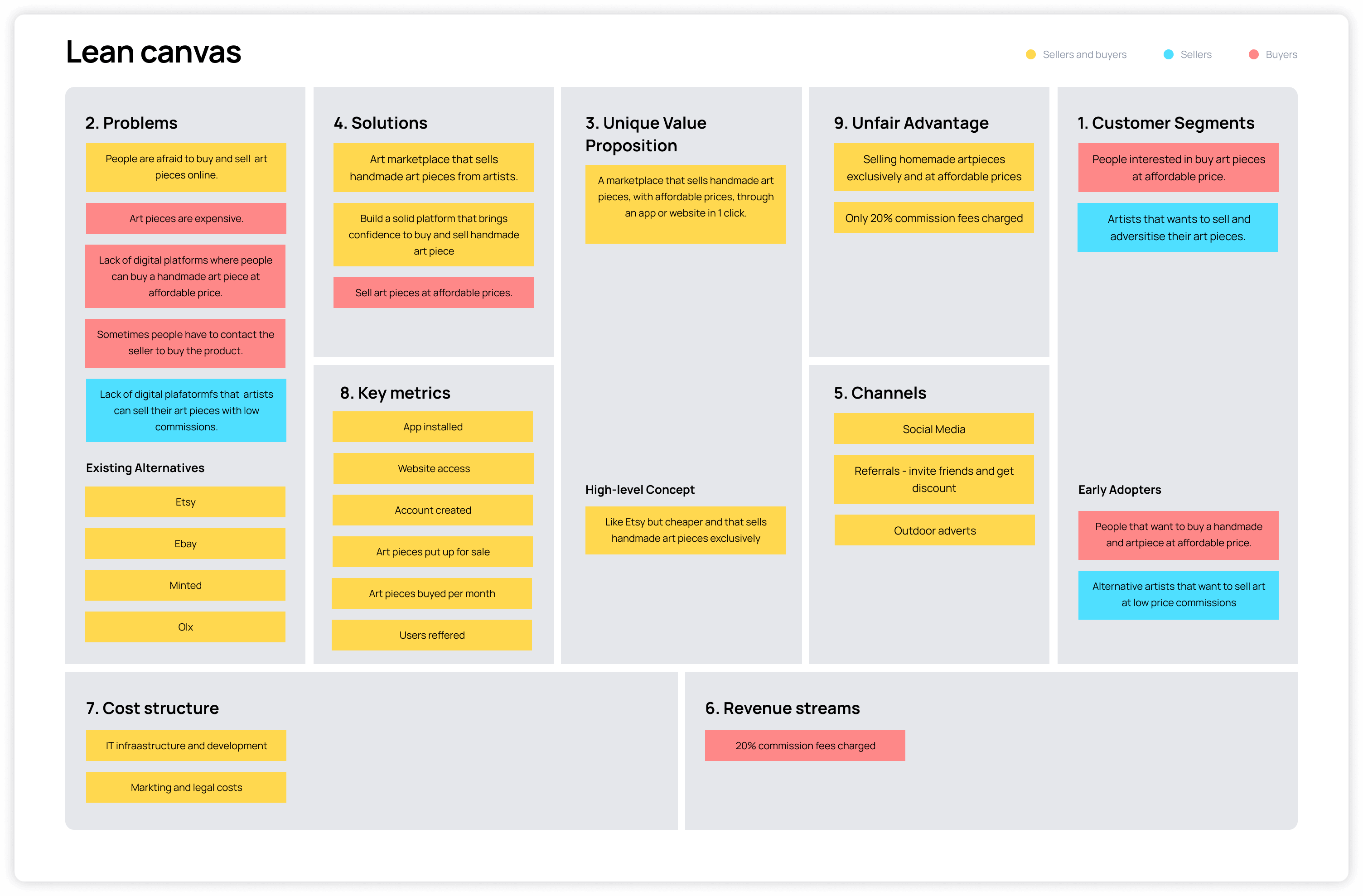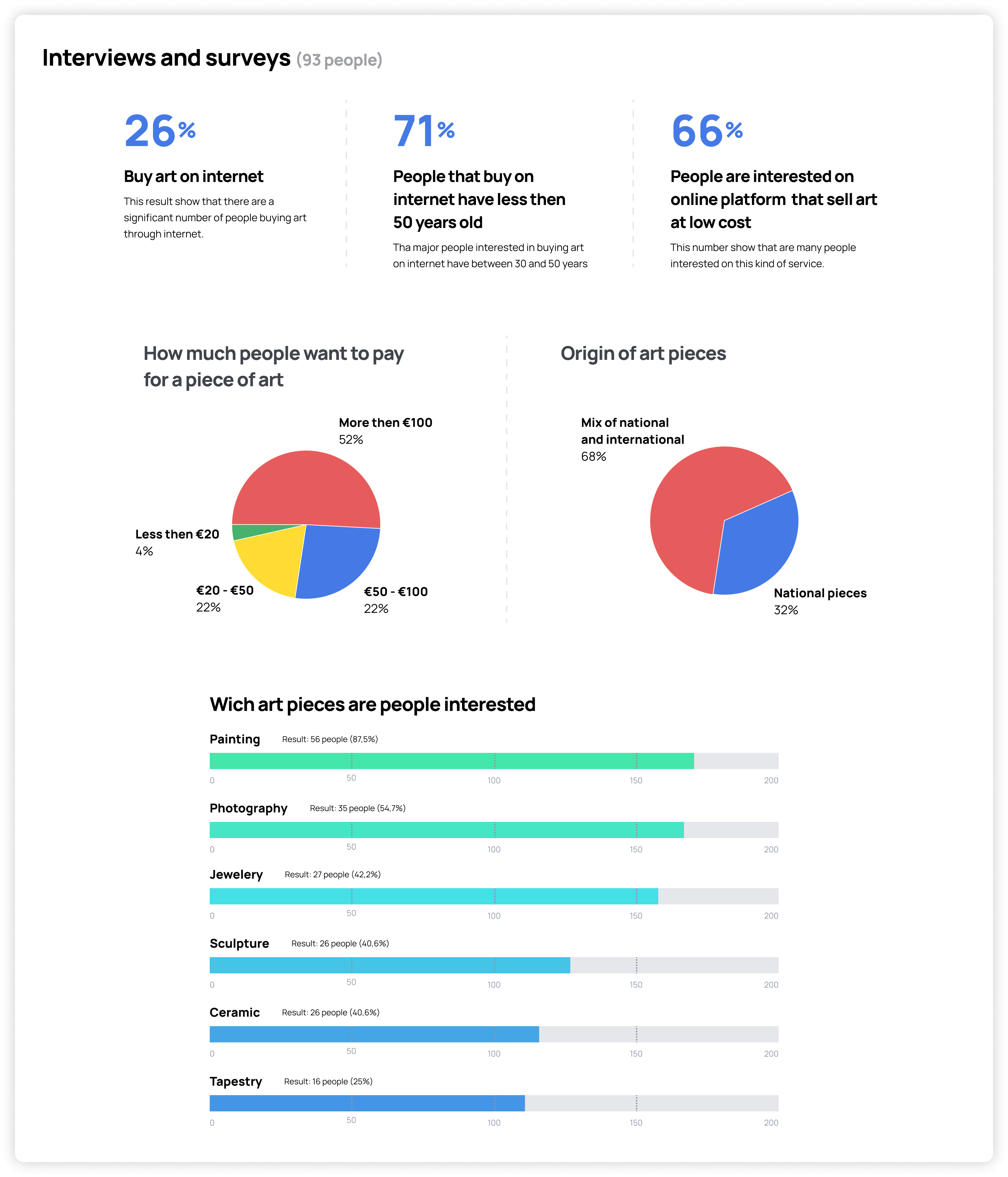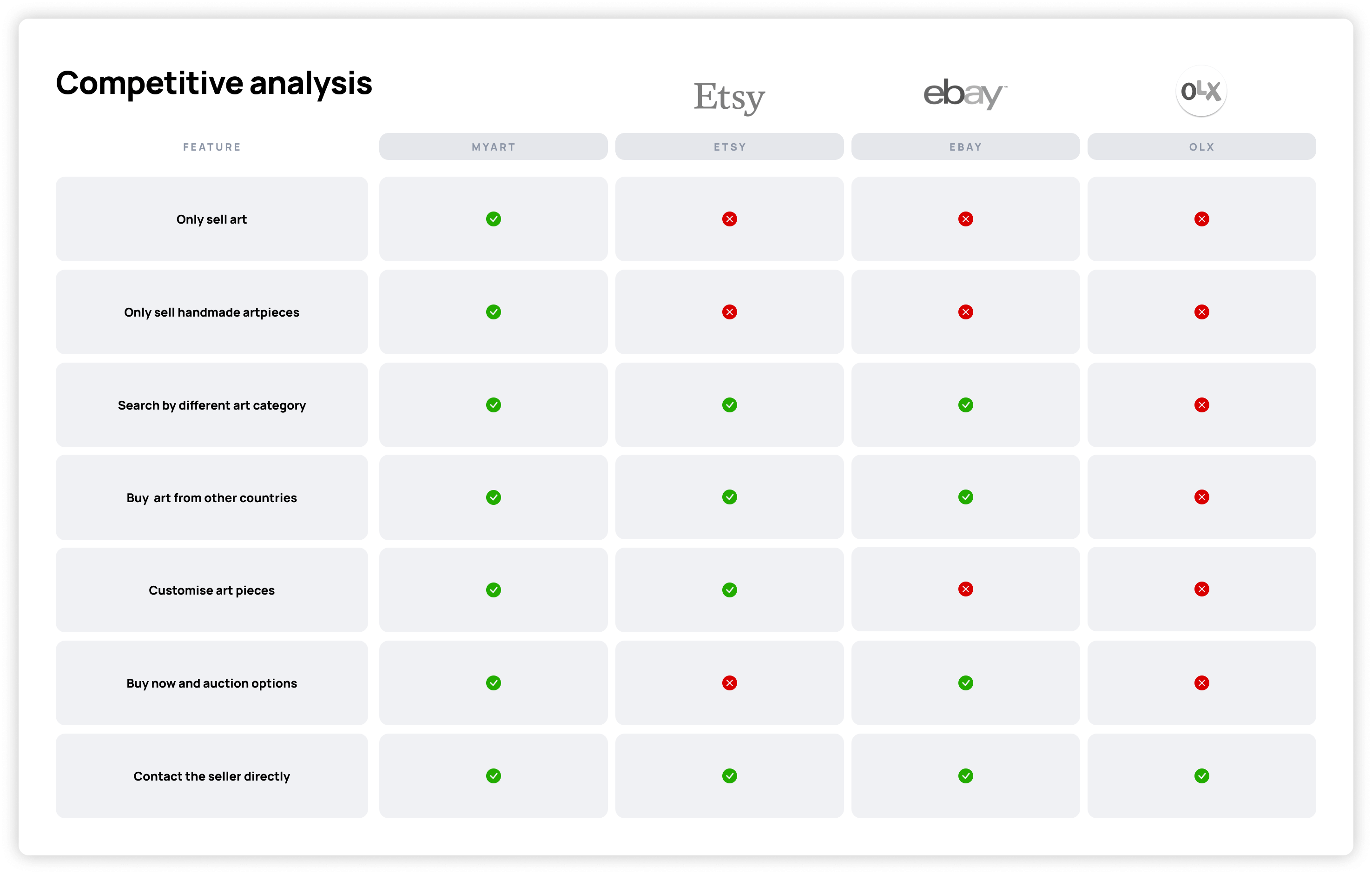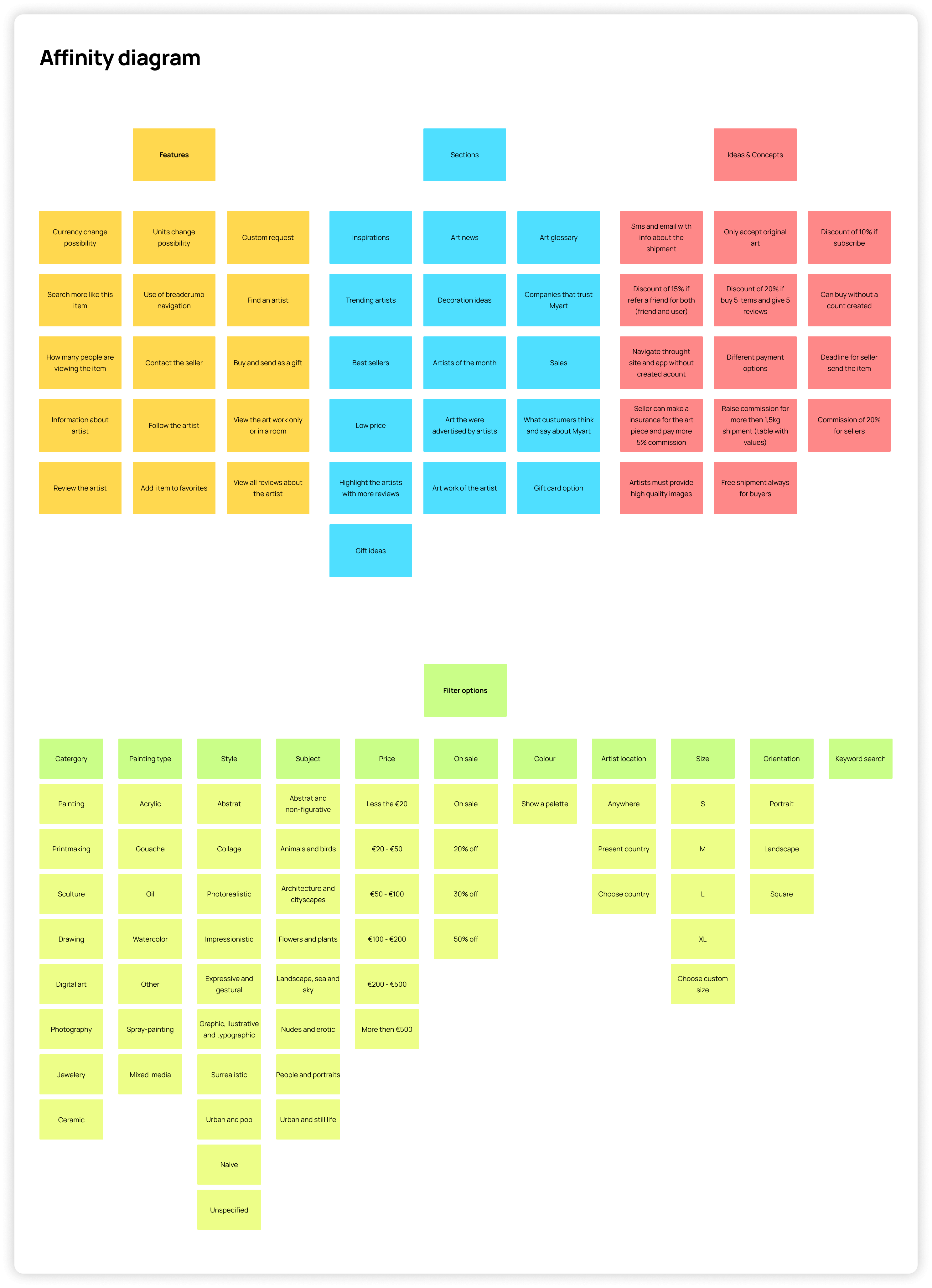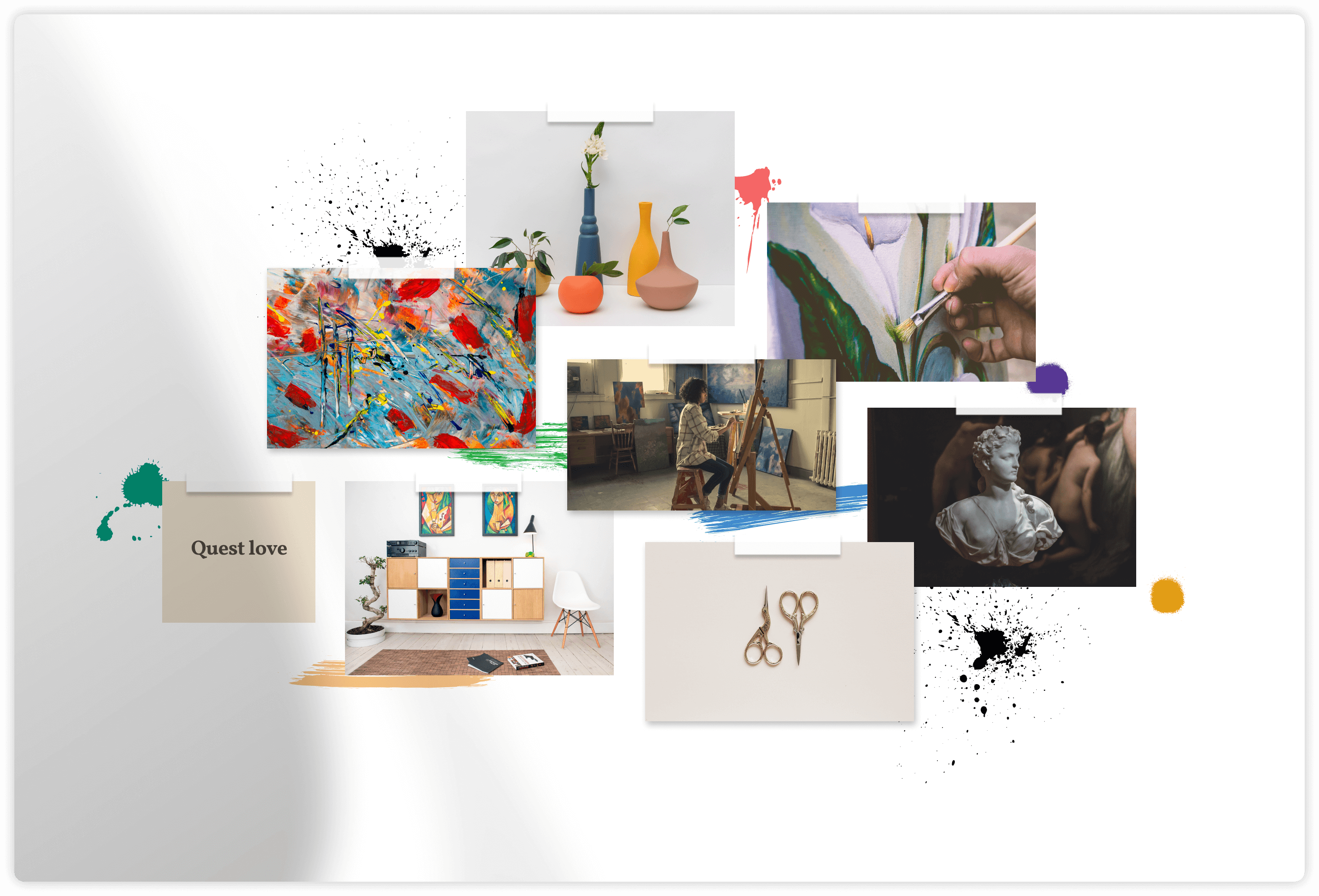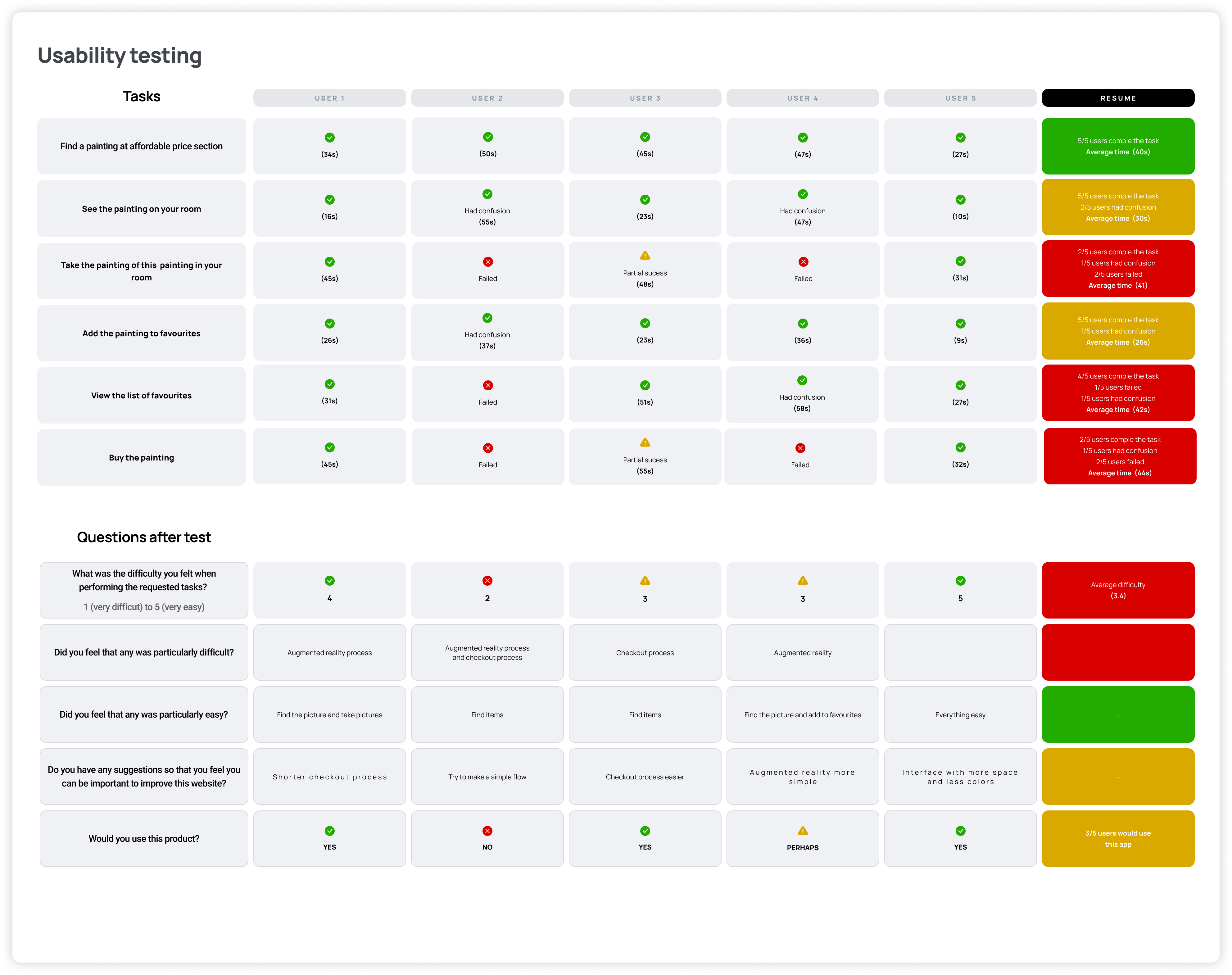The Ultimate Art Marketplace Experience
A digital platform to quickly sell and buy art pieces at affordable prices.
Overview
This project came from the idea of creating an affordable art marketplace. This platform meets the need of people looking to buy pieces of art quickly and online, in addition to serving artists who intend to sell their art and pay low commissions for the service.
Role
Product Design
Ux Research
Interactions Design
Prototyping & Testing
The Problem
Most artists find it difficult to sell their art pieces. Exhibiting artwork can be costly. Thus, it isn’t easy to maintain a profitable business, especially for those who are at the beginning of their careers or who are artists in their spare time only.
There is also a lack of platforms where artists can sell their art pieces on low commissions and people can buy them at affordable prices.
Evaluating business ideia and assumptions
This project began with the evaluation of the business idea and the identification of the riskiest assumptions to be tested. For this purpose, the Lean Canvas was used.
This canvas is extremely useful because it allows us to quickly understand the idea of the business at hand, and consequently to gain more clarity about the product and the users – which we have to keep in mind when designing the experience.
Validating hypotheses
Research is essential to obtain validation of previously assumed hypotheses and ensure that the experience that will be created meets the needs and expectations of both the user and the customer.
To perform this research, several methodologies were used, such as surveys, interviews, and secondary research.
The goal was to understand users’ needs, frustrations, expectations, and habits or preferences, be they buyers or sellers.
The data obtained are qualitative and quantitative, and enable us to better understand the attitudes and behaviors of users.
It is noted that the possible buyers are concerned with:
- the credibility of the online platform;
- confidence in the service provided;
- payment of associated postage;
- impossibility of seeing the details of the piece of art live.
These same people value buying over the internet due to the service’s speed and convenience.
Sellers claim that:
- Commissions that are charged must be around 20%
- They accept that commissions may rise depending on the purchase of insurance or the weight of the piece of art.
- Shipping must be done through a carrier, so sellers do not need to send it by mail.
Observing the competition
One of the critical parts of the research process is competitive analysis, because it allows a broad view of solutions and develops a good foundation for the designed solution.
To this end, we strategically analyze functions, features, and flows that have been implemented as solutions by competitors.
There was an intention to understand the facets of competitors, so as to strategically design solutions to create a product with a high-quality experience.
Gaining empathy with users
Once in possession of factual data and validation of our initial suppositions, it was essential to create the personas in order to gain empathy with users and better understand their needs, frustrations, motivations, and behaviors.
It is essential to grasp why these personas feel and act differently if we wish to understand which users we are trying to approach.
The personas make the design process less complex and lead us to the process of ideation.
A broad view of the users
Once a large volume of different information and data was gathered, it made sense to use a method such as the Affinity Diagram to organize and group all of this material.
At this stage of the process, it makes sense to organize and define ideas and concepts and then prepare the next step of the process, which will be idealization.
Although this method has been further developed in depth, it was also used throughout the process, constantly being reviewed and improved as insights arose at any time.
Saturating the space
Once a high volume of different information and data were gathered, it made sense to use a method such as the Affinity Diagram to organize and group all of this.
At this stage of the process it makes sense to organize and define ideas and concepts, and then prepare the next step of the process that will be the idealization.
Although this method has been further developed in-depth at this moment, it was also used throughout the process, constantly being reviewed and improved as insights arise at any time.
Prioritizing the implementation of solutions
At this stage, it was necessary to make decisions based on objective and relevant criteria instead of subjective opinions, and for that a prioritization matrix was used.
Then, it was possible to identify the problems in order to design a solution in a structured and objective way, reflecting an approach to the diverse needs of users and the business.
In this matrix, the focus was exclusively on ideas and features to implement.
Designing a flow
There is all the information needed to understand the users, the business, and what decisions will be made to create the marketplace. This stage is the ideal time for optimizing the user’s ability to perform tasks with minimal effort.
The graphical representation of the task flow is an excellent method to help design a good experience. It represents the path that users follow throughout the website.
At this stage, It was decided to use wireframes as a way to document flow.
Sketching ideas
The time has come to outline some ideas on paper, with possible solutions on how the experience for the marketplace will be created.
Through this sketch, it is possible to visualize and structure the concepts that were previously defined in the research process and then fulfill the needs of users and the business.
This is also a preparation for the next step of the UX process: creating a prototype that will be tested by the users.
Bringing inspiration to design
Creating a moodboard implies giving a chance to inspiration when designing the brand, the product and the business mission.
At this stage, it is possible to create the logo and branding of the marketplace and solidify the vision of the business: creating an affordable art sale platform for buyers and sellers.
The goal is that the marketplace will be perceived by users as fluid, friendly and easy to access.
Putting it all together in a hi-fi prototype
The final part of a UX project is the design of a high-fidelity prototype. Through this tool, it is possible to represent the visual part of the product and the experience as a whole, including interactions and user flow.
When the hi-fi prototype is finished, the moment will have come to test it with the users, receive their feedback, and confirm that the experience created fulfilled their needs.
Consistency through Design System
Creating a Design System ensures consistency when applying the necessary components to each interface of a UX project.
It is a dynamic process, since you can only define the adequate components after you test them when designing the high-fidelity prototype, and evaluate whether they meet users’ needs.
Time to test the prototype
The goal of usability testing is to validate design concepts and obtain users’ feedback about their experience when using a product. To collect the information needed, the test was recorded in video, resulting in qualitative and quantitative data for analysis.
To ensure that the users understood the test, the following explanations and instructions were given:
- The purpose of this assessment;
- Users were asked to speak out loud about what they thought and felt while completing the tasks;
- They were also asked to take the time they thought was necessary to complete the task, and only then move on to the next one;
Below are the metrics used during the test to understand how successful each result was:
- Success Rate = did they complete the task?
- Partial Success Rate = did they complete only part of the task?
- Did users make confusions?
- Time spent on the task
With the insights obtained during this usability testing, it was possible to make some adjustments to the high-fidelity prototype, in order to meet users’ needs..
Outcome
During the research, it was possible to conclude that:
- There are artists interested in selling their art pieces online on a platform that offers low commissions and shipping support to buyers.
- Some people appreciate art and would like to buy it quickly on a platform that sells art pieces at varying prices.
- Even those people who have no interest in the arts can purchase art pieces for family and friends.
The main objective of creating the marketplace developed in this project is to meet the needs mentioned above and contribute to the valorization of artistic work in society.

